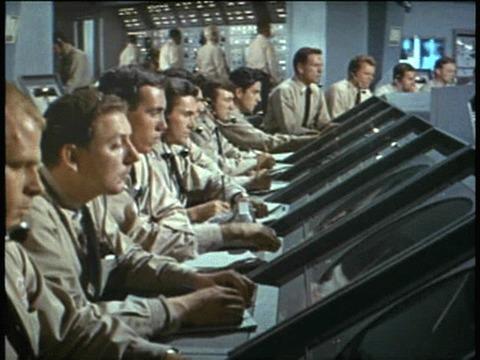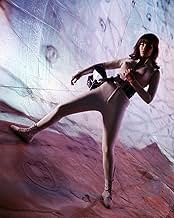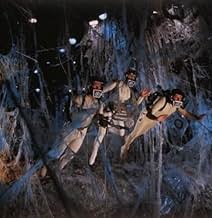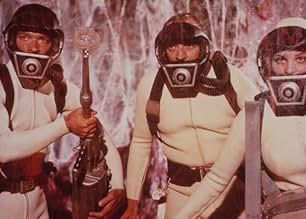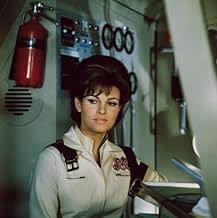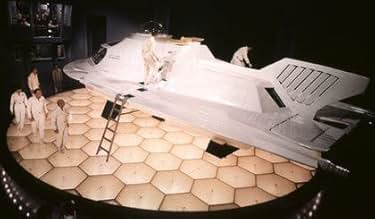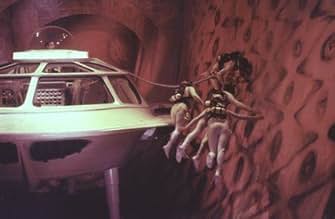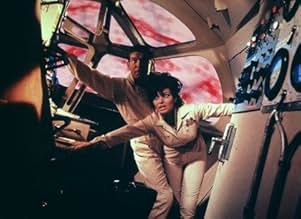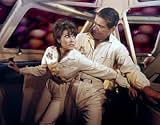VALUTAZIONE IMDb
6,8/10
21.879
LA TUA VALUTAZIONE
Uno scienziato è quasi assassinato. Per salvarlo, un sottomarino viene ridotto a dimensioni microscopiche e iniettato nel suo flusso sanguigno con un piccolo equipaggio. I problemi sorgono q... Leggi tuttoUno scienziato è quasi assassinato. Per salvarlo, un sottomarino viene ridotto a dimensioni microscopiche e iniettato nel suo flusso sanguigno con un piccolo equipaggio. I problemi sorgono quasi non appena vi entrano.Uno scienziato è quasi assassinato. Per salvarlo, un sottomarino viene ridotto a dimensioni microscopiche e iniettato nel suo flusso sanguigno con un piccolo equipaggio. I problemi sorgono quasi non appena vi entrano.
- Regia
- Sceneggiatura
- Star
- Vincitore di 2 Oscar
- 4 vittorie e 6 candidature totali
Brendon Boone
- Military Policeman
- (non citato nei titoli originali)
James Doohan
- Dr. Sawyer - Hypothermia Technician
- (non citato nei titoli originali)
Kenneth MacDonald
- Henry - Heart Monitoring
- (non citato nei titoli originali)
Christopher Riordan
- Young Scientist
- (non citato nei titoli originali)
Recensioni in evidenza
This film was originally introduced to me at about 8 or 9 years of age on a Saturday afternoon and it quickly became a favorite of mine. This film tells the story of a brilliant scientist who is injured on his way to offer the U.S. military some much needed info for miniaturizing people and objects and allowing them to stay in the miniature state beyond the now 60 minute time limit the military is faced with. With a top-notch cast that includes; Stephen Boyd, Edmond O'Brien, Donald Pleasence and Raquel Welch as the medical Dr.'s and scientists that are miniaturized and injected into the scientists body in an effort to repair a wound that can't be fixed through the usual means. The effects in this film are truly amazing and make for a lot of fun as the sub/crew journey through the body and face problems along the way, especially as they are attacked as foreign bodies by the scientist's own natural defense system. If you haven't had the pleasure of seeing this little gem, by all means find it and rent it and if it's been a while, why not revisit this film, I'm amazed at how well it stands up, even after almost 40 years since it's release.
An important diplomat is dying, Scientists hatch a plan to miniaturise a submarine team, and send them inside to attempt to carry out a life saving procedure.
I had all but forgotten about this film, and haven't seen it for years, as I watch it, it's almost sixty years old, it truly was original, ambitious, and way ahead of so many films at the time, and many more that followed.
There is plenty of wonderful, incomprehensible gobbledegook throughout, all of it is said with absolute sincerity, equally crazy and zany are the wonderfully trippy special effects.
It's still an impressive looking film, and I don't just mean the special effects, but the sets and costumes are all quite elaborate, credit to the production team for being so bold and creative.
Fans of Raquel Welch will enjoy seeing her here I'm sure, I came here because of Donald Pleasance, one of those actors I could watch in anything.
Definitely worth a few hours on a Sunday afternoon.
8/10.
I had all but forgotten about this film, and haven't seen it for years, as I watch it, it's almost sixty years old, it truly was original, ambitious, and way ahead of so many films at the time, and many more that followed.
There is plenty of wonderful, incomprehensible gobbledegook throughout, all of it is said with absolute sincerity, equally crazy and zany are the wonderfully trippy special effects.
It's still an impressive looking film, and I don't just mean the special effects, but the sets and costumes are all quite elaborate, credit to the production team for being so bold and creative.
Fans of Raquel Welch will enjoy seeing her here I'm sure, I came here because of Donald Pleasance, one of those actors I could watch in anything.
Definitely worth a few hours on a Sunday afternoon.
8/10.
"Fantastic Voyage" follows a surgical team of three scientists: Dr Peter Duval, the top brain surgeon in the country (Arthur Kennedy); Cora Peterson, his technical assistant (Raquel Welch); Dr Michaels, chief of the medical mission (Donald Pleasance), plus the skipper of the ship (William Redfield) and Grant (Stephen Boyd) the security agent for security purposes...
The sealed vesselThe Proteusis reduced down by a secret branch called CMDF (Combined Miniature Deterrent Forces) and injected into one artery of a defecting Russian scientist who has suffered brain injury and he's in a coma from an assassination attempt... The crew must navigate to the scientist's brain (within exactly 60 minutes) where Dr Duval will attempt to dissolve the coagulum with a laser beam After that everything starts growing back to its original size
"Fantastic Voyage" is a film of authentic wonder: An ocean of life, the corpuscles, the heart, the lungs of the human body through which the crew move are exquisitely designed in great detail with artistic quality...
The plot creates unceasing moments of suspense as the ship and its crew are continually threatened by the scientist's natural defenses: white corpuscles, reticular fibers, antibodies and other factors Leonard Rosenman's futuristic score nicely complements the adventure on screen with the strange sound of the human blood rushing through arteries, veins, rhythmical muscular movements, and of course, the sabotage occurred on board
With two Oscar Awards for Best Visual Effects and Best Art Direction, 'Fatastic Voyage' is certainly the most unusual journey into the human body, where the 'medieval philosophers were right. Man is the center of the universe. We stand in the middle of infinity, between outer and inner space. And there's no limit to either.'
The sealed vesselThe Proteusis reduced down by a secret branch called CMDF (Combined Miniature Deterrent Forces) and injected into one artery of a defecting Russian scientist who has suffered brain injury and he's in a coma from an assassination attempt... The crew must navigate to the scientist's brain (within exactly 60 minutes) where Dr Duval will attempt to dissolve the coagulum with a laser beam After that everything starts growing back to its original size
"Fantastic Voyage" is a film of authentic wonder: An ocean of life, the corpuscles, the heart, the lungs of the human body through which the crew move are exquisitely designed in great detail with artistic quality...
The plot creates unceasing moments of suspense as the ship and its crew are continually threatened by the scientist's natural defenses: white corpuscles, reticular fibers, antibodies and other factors Leonard Rosenman's futuristic score nicely complements the adventure on screen with the strange sound of the human blood rushing through arteries, veins, rhythmical muscular movements, and of course, the sabotage occurred on board
With two Oscar Awards for Best Visual Effects and Best Art Direction, 'Fatastic Voyage' is certainly the most unusual journey into the human body, where the 'medieval philosophers were right. Man is the center of the universe. We stand in the middle of infinity, between outer and inner space. And there's no limit to either.'
To answer everyone's question about how did Issac Asimov resolve the Proteus issue at the end of the movie; in his novelization of the film (which is a very good sci-fi book on its own), the sub comes out with everyone else in the teardrop along with "a very surprised white blood cell." The scene with Donald Pleasance gave me chills when I saw it as a child and having recently seen it again, it still is creepy. I think this is due to Pleasance's performance more than anything else. I do have to say that seeing Stephen Boyd being driven around the LA Sports Center (subbing for the top secret research center; they had to have everything removed by 5:30 in the afternoon the week they filmed there because sporting events were going on at night) in a golf cart seemed a bit silly but I guess that showed how important he was. With these kinds of films, one has to ignore all certain types of questions about how come this did or didn't happen when the scientists did this and just relax and enjoy it.
Back in 1966, long, long before the world was turned upside down and inside out on Sept. 11, the world was a very different place. The movies were quite different and science fiction pictures depended more on good writing and less on special effects. Partly because the phrase "computer generated" was years away. In 1966, 20th Century Fox released a very clever, well-written and innovative movie called, "Fantastic Voyage". The on-screen foreword informed the viewers that they were going to be taken to a place that no one had been before, and see things that had been, until that point in time, never been seen by human beings. I'm sure that this film had its fair share of technical advisors putting in a lot more than their 2 cents worth to make sure that the film accurately depicted human anatomy. The plot... A scientist, Jan Benes, has defected from behind the Iron Curtain, has, with the help of Grant, one of our top CIA operatives. Benes has decided to give his expertise with Miniaturization to the US. The "other side" has no choice but to try to kill him before he can breathe a word of it. The assassination attempt is made, but Benes barely survives, falling into a coma. After the movie's credits finish rolling, Grant is brought to a secret, gov't location. There, he meets Gen. Carter, who is in charge of the CMDF - Combined Miniature Deterent Forces. They can shrink anything; cars, planes, tanks, people way down in size, thus enabling them to become unseen military weapons. The problem: both sides have this capability. Another problem is... there is a time limit. They can only stay miniaturized for 60 minutes. After that the object or person automatically starts to grow. Benes had the answer to this problem, but he will need special medical treatment to regain consciousness. That's where Grant and a special team of doctors, technicians and such will have to go into action. After Grant meets the rest of the team, the surgeons in charge, Dr. Duvall and Dr. Michaels go over their plan to remove the blood clot in Benes' brain. They will board a special Navy submarine, called The Proteus, be miniaturized and injected into Benes' body by hypodermic needle. Naturally, the crew runs into Murphy's Law and a job that was expected to take 10 to 15 minutes takes much, much longer. The ending in the movie differs quite a bit from the book written by Isaac Azimov (I know because I read it... twice), and there are a number sub-plot twists that made me shake my head, but seeing Ms. Welch in that wet suit made it more than worth while. I consider this movie to be one of my very favorite sci-fi/fantasy flicks from the '60s. If you haven't seen it yet, for whatever reason, I can suggest you spend the 100 minutes with some very fine actors, some of whom are no longer with us, such as Stephen Boyd (Grant), Edmund O'Brien (Gen. Carter) and Arthur O'Connell who was in charge of the medical team, and others like Arthur Kennedy (Dr. Duvall), Donald Pleasence (Dr. Michaels) and last but not least, the ever-beautiful, Raquel Welch as Cora Peterson, Dr. Duval's technical assistant. One last thought.... if this movie was remade with present-day technology, i.e. computer generated imaging and the like, there's no telling how it would dazzle the viewers' eye.
Lo sapevi?
- QuizMedical schools, at least as late as the 1980s, showed clips from this movie to illustrate various concepts in human anatomy, physiology, and especially immunology.
- BlooperThe amount of radioactive material for the sub would not need a lead carrying case. Grant proves this by removing the container from the case with no protection and handing it to Owens who inserts it into the reactor, again bare-handed.
- Versioni alternativeThe DVD edition has the following prologue: "The makers of this film are indebted to the many doctors, technicians and research scientists, whose knowledge and insight helped guide this production" The TV/Video version features this prologue instead: "This film will take you where no one has ever been before; no eye witness has actually seen what you are about to see. But in this world of ours where going to the moon will soon be upon us and where the most incredible things are happening all around us, someday, perhaps tomorrow, the fantastic events you are about to see can and will take place."
- ConnessioniEdited into Attack of the 50 Foot Monster Mania (1999)
I più visti
Accedi per valutare e creare un elenco di titoli salvati per ottenere consigli personalizzati
Dettagli
- Data di uscita
- Paese di origine
- Lingua
- Celebre anche come
- Fantastic Voyage
- Luoghi delle riprese
- Los Angeles Memorial Sports Arena - 3939 S. Figueroa Street, Los Angeles, California, Stati Uniti(interior corridors of CMDF headquarters traversed by golf carts and people walking)
- Azienda produttrice
- Vedi altri crediti dell’azienda su IMDbPro
Botteghino
- Budget
- 5.115.000 USD (previsto)
- Tempo di esecuzione1 ora 40 minuti
- Colore
- Proporzioni
- 2.35 : 1
Contribuisci a questa pagina
Suggerisci una modifica o aggiungi i contenuti mancanti

Divario superiore
By what name was Viaggio allucinante (1966) officially released in India in English?
Rispondi
